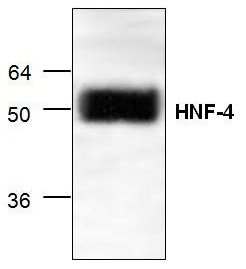HNF-4 Antibody
Rabbit Polyclonal Antibody
- SPECIFICATION
- CITATIONS
- PROTOCOLS
- BACKGROUND

Application
| WB |
|---|---|
| Primary Accession | P22449 |
| Other Accession | EDL96573 |
| Reactivity | Mouse, Rat |
| Host | Rabbit |
| Clonality | Polyclonal |
| Isotype | Rabbit IgG |
| Calculated MW | 52712 Da |
| Gene ID | 25735 |
|---|---|
| Application & Usage | Western blotting (0.5-4 µg/ml). However, the optimal concentrations should be determined individually. Mouse small intestine and rat kidney tissue lysates can be used as positive controls. |
| Other Names | HNF4A , TCF , MODY 1 , MODY , TCF14 , FLJ39654 , HNF4 , HNF 4 |
| Target/Specificity | HNF 4 |
| Antibody Form | Liquid |
| Appearance | Colorless liquid |
| Formulation | 100 µg (0.5 mg/ml) affinity purified rabbit polyclonal antibody in phosphate-buffered saline (PBS) containing 30% glycerol, 0.5% BSA, and 0.01% thimerosal. |
| Handling | The antibody solution should be gently mixed before use. |
| Reconstitution & Storage | -20 °C |
| Background Descriptions | |
| Precautions | HNF-4 Antibody is for research use only and not for use in diagnostic or therapeutic procedures. |
| Name | Hnf4a |
|---|---|
| Synonyms | Hnf-4, Hnf4, Nr2a1, Tcf14 |
| Function | Transcriptional regulator which controls the expression of hepatic genes during the transition of endodermal cells to hepatic progenitor cells, facilitating the recruitment of RNA pol II to the promoters of target genes (By similarity). Activates the transcription of CYP2C38 (By similarity). Represses the CLOCK-BMAL1 transcriptional activity and is essential for circadian rhythm maintenance and period regulation in the liver and colon cells (By similarity). |
| Cellular Location | Nucleus. |
| Tissue Location | Liver, kidney and intestine. |

Thousands of laboratories across the world have published research that depended on the performance of antibodies from Abcepta to advance their research. Check out links to articles that cite our products in major peer-reviewed journals, organized by research category.
info@abcepta.com, and receive a free "I Love Antibodies" mug.
Provided below are standard protocols that you may find useful for product applications.
Background
HNF-4 (Hepatocyte nuclear factor 4), a member of the steroid/thyroid nuclear receptor superfamily, is a transcriptional factor which expresses in the liver, intestine, kidney, and pancreatic cells. It contains several functional domains: a ligand-independent activation domain (AF1), a zinc finger DNA binding domain, and a ligand-dependent activation domain (AF2). HNF-4 binds to a specific DNA element as a homodimer and regulates the expression of many genes, involved in glucose, fatty acid, and cholesterol metabolisms.
If you have used an Abcepta product and would like to share how it has performed, please click on the "Submit Review" button and provide the requested information. Our staff will examine and post your review and contact you if needed.
If you have any additional inquiries please email technical services at tech@abcepta.com.













 Foundational characteristics of cancer include proliferation, angiogenesis, migration, evasion of apoptosis, and cellular immortality. Find key markers for these cellular processes and antibodies to detect them.
Foundational characteristics of cancer include proliferation, angiogenesis, migration, evasion of apoptosis, and cellular immortality. Find key markers for these cellular processes and antibodies to detect them. The SUMOplot™ Analysis Program predicts and scores sumoylation sites in your protein. SUMOylation is a post-translational modification involved in various cellular processes, such as nuclear-cytosolic transport, transcriptional regulation, apoptosis, protein stability, response to stress, and progression through the cell cycle.
The SUMOplot™ Analysis Program predicts and scores sumoylation sites in your protein. SUMOylation is a post-translational modification involved in various cellular processes, such as nuclear-cytosolic transport, transcriptional regulation, apoptosis, protein stability, response to stress, and progression through the cell cycle. The Autophagy Receptor Motif Plotter predicts and scores autophagy receptor binding sites in your protein. Identifying proteins connected to this pathway is critical to understanding the role of autophagy in physiological as well as pathological processes such as development, differentiation, neurodegenerative diseases, stress, infection, and cancer.
The Autophagy Receptor Motif Plotter predicts and scores autophagy receptor binding sites in your protein. Identifying proteins connected to this pathway is critical to understanding the role of autophagy in physiological as well as pathological processes such as development, differentiation, neurodegenerative diseases, stress, infection, and cancer.


